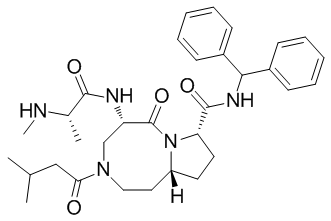All AbMole products are for research use only, cannot be used for human consumption.

AT-406 (formerly known as SM-406) is a novel and orally active antagonist of multiple IAP proteins. AT-406 selectively inhibits the biological activity of IAP proteins, including X chromosome-linked IAP (XIAP), the cellular IAPs 1 (c-IAP1) and 2 (c-IAP2) and melanoma inhibitor of apoptosis protein (ML-IAP). AT-406 effectively antagonizes XIAP BIR3 protein in a cell-free functional assay. AT-406 induced apoptosis is correlated with its ability to down-regulate XIAP whereas AT-406 induces cIAP1 degradation in both AT-406 sensitive and resistance cell lines. AT-406 is highly effective in induction of apoptosis in xenograft tumors, and is capable of complete inhibition of tumor growth. Additionally, AT-406 enhances the carboplatin-induced ovarian cancer cell death and increases survival of the experimental mice in vivo. AT-406 is currently in phase I clinical trials for the treatment of human cancer.
| Cell Experiment | |
|---|---|
| Cell lines | MDA-MB-231 breast cancer and SK-OV-3 ovarian cancer cell lines |
| Preparation method | The MDA-MB-231 breast cancer and SK-OV-3 ovarian cancer cell lines were purchased from the American Type Culture Collection (ATCC). Cells were seeded in 96-well flat bottom cell culture plates at a density of 3–4×103 cells/well with compounds and incubated for 4 days. The rate of cell growth inhibition after treatment with different concentrations of the inhibitors was determined by assaying with (2-(2-methoxy-4-nitrophenyl)-3-(4-nitrophenyl)-5-(2,4-disulfophenyl)-2H-tetrazolium mono-sodium salt. WST-8 was added to each well to a final concentration of 10%, and then the plates were incubated at 37°C for 2–3 h. The absorbance of the samples was measured at 450 nm using a TECAN ULTRA Reader. Concentration of the compounds that inhibited cell growth by 50% (IC50) was calculated by comparing absorbance in the untreated cells and the cells treated with the compounds. |
| Concentrations | 0~3000 nM |
| Incubation time | 4 days |
| Animal Experiment | |
|---|---|
| Animal models | SCID mice (8–10 per group) bearing MDA-MB-231 xenograft model |
| Formulation | saline |
| Dosages | 10,30 and 100 mg/kg 5 days a week for 2 weeks |
| Administration | oral gavage |
| Molecular Weight | 561.71 |
| Formula | C32H43N5O4 |
| CAS Number | 1071992-99-8 |
| Solubility (25°C) | DMSO 85 mg/mL Ethanol 85 mg/mL |
| Storage |
Powder -20°C 3 years ; 4°C 2 years In solvent -80°C 6 months ; -20°C 1 month |
| Related IAP Products |
|---|
| AZD5582 dihydrochloride
AZD5582 dihydrochloride is an antagonist of the inhibitor of apoptosis proteins (IAPs), which binds to the BIR3 domains cIAP1, cIAP2, and XIAP with IC50s of 15, 21, and 15 nM, respectively. |
| Sanggenon G
Sanggenon G is a cell-permeable and potent inhibitor of X-linked inhibitor of apoptosis protein (XIAP). |
| TD-1092
TD-1092 is a pan-inhibitor of apoptosis (IAP) degrader with two different types of E3 ligase conjugates, IAP and CRBN, that induces proteasomal degradation of cIAP2 and XIAP in a CRBN-dependent manner. TD1092 also activates apoptotic proteases (apoptosis 3/7) and leads to apoptosis by promoting IAP degradation. In addition, TD1092 also blocks the TNFα-mediated NF-κB signaling pathway and inhibits the phosphorylation of IKK, IkBα, p65, and p38. TD1092 can be used as a PROTAC for cancer research. |
| LBW242
LBW242, a 3-mer and Smac mimetic, is a potent and orally active proapoptotic IAP inhibitor. LBW242 shows effects on mutant FLT3-expressing cells. LBW242 has activity against multiple myeloma, and potentiates TRAIL- and anticancer agent-mediated cell death of ovarian cancer cells. |
| UC-112
UC-112 is a novel potent IAP(Inhibitor of apoptosis) inhibitor. UC-112 potently inhibit cell growth in two human melanoma (A375 and M14) and two human prostate (PC-3 and DU145) cancer cell lines(IC50=0.7-3.4 uM). |
All AbMole products are for research use only, cannot be used for human consumption or veterinary use. We do not provide products or services to individuals. Please comply with the intended use and do not use AbMole products for any other purpose.


Products are for research use only. Not for human use. We do not sell to patients.
© Copyright 2010-2024 AbMole BioScience. All Rights Reserved.
